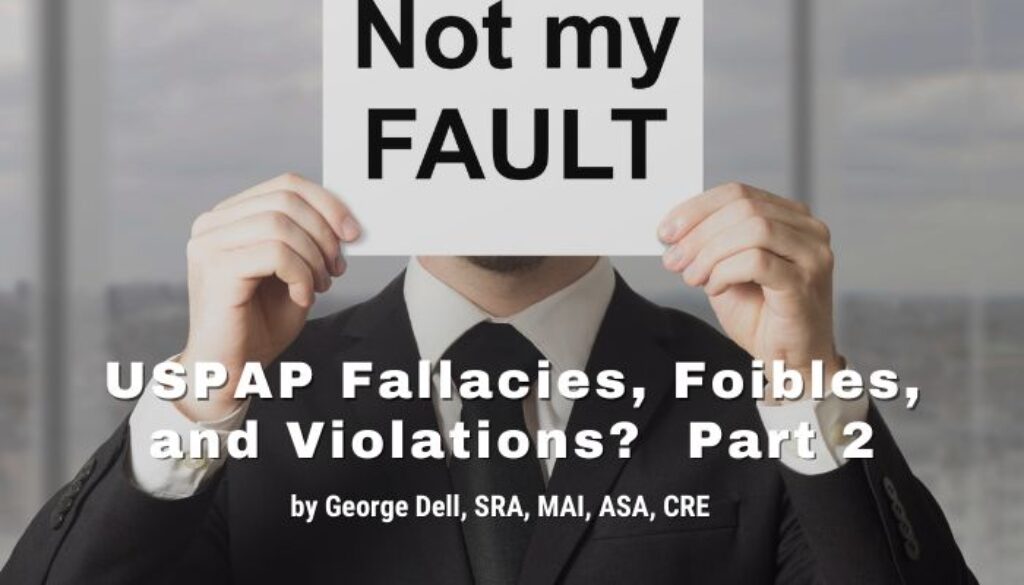The second of our “foibles” in USPAP may be from that same paragraph on page (ii), noted last week. This paragraph effectively sets the mission statement for the Appraisal Foundation.
The paragraph is titled: “ABOUT THE APPRAISAL FOUNDATION.” It states the AF provides “guidance on recognized valuation methods and techniques for all valuation professionals.” [Emphases added].
So what’s the problem? There may be two in one sentence . . .
The world continues to change.
Those recognized methods and techniques were developed early in the last century. We don’t even properly call them them “methods and techniques.” We call them models and algorithms. (Less art, more science.)
Analysts make decisions and judgments about models. Computer power carries out the algorithms. Today’s AF standards were substantially written before even hand calculators were available! No algorithms. Not the way we know them today!
Those Appraisal Standards were substantially written for the AIREA and the SREA, the predecessor organizations to today’s Appraisal Institute. They were adapted with input from the ASA and other appraisal organizations for final “ownership” by the AF.
The USPAP then became an “annually revised” quasi-governmental document. Which in turn became irregularly and unevenly “enforced “ by 54 states and territories.
And further in turn, it conflicted with several alternative standards of federal organizations, the professional groups, and international valuation standards (IVS).
AVMs (Automated Valuation Standards) have no standards. “Interagency” evaluations, which may be performed by a non-appraiser, have lesser/different/vaguer requirements. And of course, many loans can be made based on “appraisal waivers,” third-party inspections, “desktops” or “hybrids.” All these have to do with “methods and techniques” and inspection (data collection) conditions – but not directly about accuracy, unbiasedness, or reliability.
Phew!
Yet all of these require some predetermination of risk. Risk that the valuation is itself a part of. We measure risk by predetermining the expected risk!
So, what are “recognized methods and techniques”? It appears that only licensed appraisers are required to do it the old way. The way developed in the last century.
The recognized methods comprise the “three approaches to value:” cost, income, comparison.
So what’s the issue? Let’s revisit our topic sentence: The AF provides “guidance on recognized valuation methods and techniques for all valuation professionals.” Two issues here:
- What is recognized, and what is “not recognized?” Recognized seems to mean only the three legacy “approaches.” Apparently not data science protocol, not focus on market analysis, not focus on measurable reliability, and not focus on limiting opportunity for bias!
- Who are all valuation professionals? USPAP only applies to licensed appraisers in the several states. It appears that the AF quasi-legal standards only apply to a few. All others appear to be exempt!
Can we conclude that USPAP does not apply to “all valuation professionals?” Can we conclude that the restriction to “recognized” methods and techniques holds back, and or even precludes progress in data management, predictive methods, and today’s dramatically-changed role of professional judgment.

December 5, 2024 @ 7:25 am
Regarding recognized methods and techniques, and the 3 approaches to value, one of the the issues I often see with the majority of Appraisals I review or have reviewed is that the Appraisal lacks support, disclosure and rationale for “The Exclusion Of A Value Approach” (mainly Cost and Income). Do a Cntrl “F” in your digital copy of USAP to Find the word “Exclusion”. Just one Example: how often do VA Appraisals include the development of the CA or proper Exclusion of the CA? I am not certain, however, apparently VA no longer requires development of CA. IMO, just because VA may not require development of CA and/or IA, those reports still need to comply with USPAP regarding exclusion of the approach. Although I am no longer a VA Appraiser, when I was on the Panel for a 10 year period we were required to, at minimum, provide the site value, and we always developed the CA on new or recent (within 5 yrs) construction. How many VA/FHA/Conv Appraisals include proper disclosure, support and rationale for Exclusion of Income Approach?
OFF TOPIC but something to ponder: Some States are “Voluntary” with regard to USPAP Compliance on non-FRT’s (Federally Related Transactions). My State is voluntary, however, the Board mandated that all reports written as and called “Appraisals” need to comply with all USPAP Rules. However, it is my understanding, and correct me if I’m wrong, that other Voluntary States which have not made such a compliance mandate, the Appraiser is only required to comply with USPAP Ethics and Competency Rules. I suspect most Appraisers are not even aware of the term “Voluntary State”, as it relates to USPAP compliance.